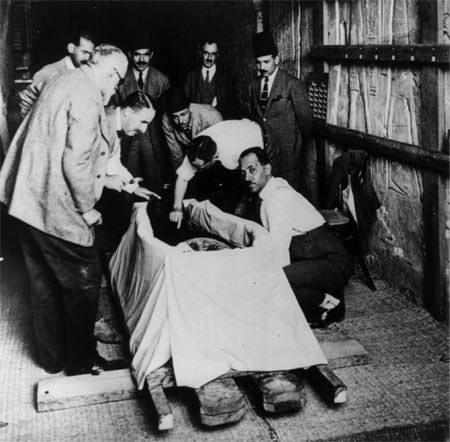
The habits in everyday life of the Ancient Egyptians were led by magical thinking. It is based on certain principles and shaped together with religion and mythology the worldview of those people. In this post, I want to write about magic and magical practices in Ancient Egypt.
HEKA: the Magical Power
The Egyptian word heka goes back to the very early times in the beginning of what we call today the Ancient Egyptian Culture, namely around 6000 B.C. The sun god Ra himself manifests by heka - the life force of creation or magical power. There are religious recordings of heka that says the creator gave heka to humankind as a "weapon in order to stroke off a (harming) event."[1]
Heka was written in the hieroglyph 𓋾 and is transcribed with ḥḳꜢ. This sign is also a part of the kings ornate shown by the heka-scepter. See another article about the royal insignia: @laylahsophia/egyptology-all-hail-the-king.

The purpose of the use of magic was to handle situations that are confusing and irrational in areas like sustenance and agriculture, techniques, personal and medical security, the social status and - of course - all things belonging to the afterlife. Magic was achieved through cultic practices like rituals, hymns, the calendar, prayers, divination and explaining of dreams.[2]
The Principles of Magic
Modern scholars define Ancient Egyptian Magic by classifying it into three categories:

- The productive category seeks success through magic in crafts and professions. A high level of skills was necessary to predict the annual flood, for instance, the knowledge about agriculture and so on. Love magic was also a common practice. We know this especially from written spells in terms of medical treatments. The last point is also directly connected with magic, but often more in a defensive way by defeating demons that caused the illness. Divination by priests and oracles by the local scorpion charmer can also be placed in that category.[3]


Professional Magicians
In Ancient Egypt, there was no clear distinction between a priest that was responsible for the execution of the daily cult in the temple, the magician that made divinations and oracles to predict the future and medical healers[7] that used magic in their treatments. That shows the tight weaving of those crafts and their importance in the everyday life. Magic was an inherent part of the world in Ancient Egypt and had an impact on almost everything they did and said.

The Curse of the Pharao?
Many people heard of the curse of the Pharao that had a deep impact on how we perceive today this ancient culture. Is this true? Did the Pharao put a (defensive) spell on all potential tomb robbers in the future?
There are two things to distinguish: it was a common practice in some periods of the Ancient Egyptian culture when tomb owners warned people when they passed by a tomb. In many cases, after the death of a person, his relatives practised a death cult by bringing food and other supplies to the tomb for a while. They were convinced the tomb owner needed some magical support on his way to the afterlife and so they put goods as offerings to the gods and also to provide the deceased with all that's necessary on the "other side". So the tombs itself were visible for a long time and potential tomb robbers would know the places were the treasures were. To prevent them from breaking in the entrances of the tombs were written with magical spells like (simplified): "This is my tomb. If you break in, you will be punished." It is also known as "Call on the Living" (German: "Anruf an die Lebenden"). The living people should be warned of the deceased's power from the afterlife.[8]

Footnotes and sources:
[1] Borghouts, J.F., in: Lexikon der Ägyptologie III, Wiesbden 1980, cols. 1137–1151 (1141), s.v. Magie.
[2] loc. cit. cols. 1141 f.
[3] loc. cit. col. 1142.
[4] so called "curse tablets" (German: Fluchtäfelchen) were used like amuletts and were a phenomenon of the late periods. See: Uttermann, Matthias, Ägyptische Magie im Wandel der Zeiten, Heidelberg 2011, Online available as PDF. Source
[5] Borghouts, J.F., in: Lexikon der Ägyptologie III, Wiesbden 1980, cols. 1137–1151 (1143), s.v. Magie.
[6] loc. cit. col. 1144.
[7] see: Papyrus Ebers; Ritner, Robert K., Innovations and Adaptations in Ancient Egyptian Medicine, in: Journal of Near Eastern Studies.
Vol. 59, No. 2 (Apr., 2000), pp. 107-117, http://www.jstor.org/stable/545610.
[8] Assmann, Jan, Tod und Jenseits in Ägypten, München 2001.
Images:
Image used in the editorial picture is a so called Ka-Statue. Source.
Graphical overview of magical categories: my own work.
Image 1 Source
Image 2 Source
Image 3: Uttermann, Matthias, Ägyptische Magie im Wandel der Zeiten, Heidelberg 2011, page 9.;
Image 4 Source; Image 5 Source
Feel free to ask all the question of what you always wanted to know about Ancient Egypt. That’s my job and my passion. Let’s discuss your thoughts and ideas.

If you liked this article, please follow me on my blog @laylahsophia. I am a german Egyptologist writing about ancient and contemporary Egypt, history of science, philosophy and life.
